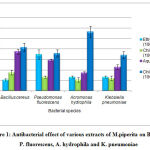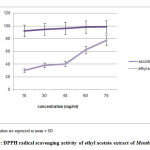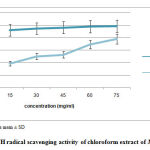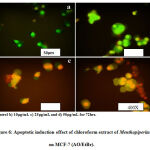Manuscript accepted on :21-09-2021
Published online on: 24-09-2021
Plagiarism Check: Yes
Reviewed by: Dr. Rai, Vikrant

Second Review by: Dr. Hind Shakir

Final Approval by: Dr. Gul Ozcan
Renuka Saravanan , Ravichandran Natesan
, Ravichandran Natesan , Sumathi C Samiappan
, Sumathi C Samiappan , Sivakumar Ramalingam*
, Sivakumar Ramalingam*
Department of Chemistry and Biosciences, SASTRA University, Srinivasa Ramanujam Centre, Kumbakonam 612001, Tamil Nadu, India.
DOI : https://dx.doi.org/10.13005/bpj/2270
Abstract
The study evaluates the antioxidant, antibacterial and anticancer activities of different extracts of Menthapiperitaleaves against the MCF-7 cell line. The leaves of Menthapiperitawere extracted with aqueous, ethyl acetate, and chloroform. These extracts were subjected to qualitative phytochemical screening, antibacterial activity, cytotoxic activity, and AO/ErBr assay for cells' apoptotic effect against the MCF-7 cell line. Qualitative analysis of the leaves' different extracts revealed glycosides, alkaloids, flavonoids, terpenoids, tannin, and saponin. The antibacterial activity of the leaf extracts was examined against four different bacterial species (Bacillus cereus, Pseudomonasfluorescens, Aeromonas hydrophila, and Klebsiella pneumoniae). The aqueous extract exhibited a high level of antibacterial activity (18.66mm ±1.1 in Bacillus cereus).Free‑radicalscavenging activity of chloroform extractof M. piperita leaves was found to be more than aqueous and ethyl acetate extracts. Further, aqueous, ethyl acetate,and chloroform extracts exerted a cytotoxic effect with the IC50value of 45±1.5μg/ml, 29±1.2μg/ml, and 24±1.0μg/ml, respectively.From this study, we have observed that chloroform extract showed a concentration-dependent apoptotic effect against MCF-7 cellsdetermined by AO/EtBr assay.The resultsfurther depicted that the selected traditionalMentha piperita could be used as a potential anticancer, antibacterial, and good antioxidant agent against the MCF-7 cell line.
Keywords
Anti-oxidant; Anti-bacterial; Anti-cancer; Mentha piperita, MCF-7
Download this article as:| Copy the following to cite this article: Saravanan R, Natesan R, Samiappan S. C, Ramalingam S. Anti-Oxidant, Anti-Bacterial and Anti-Cancer Activity of Mentha Piperita Against Mcf-7 Cells. Biomed Pharmacol J 2021;14(3). |
| Copy the following to cite this URL: Saravanan R, Natesan R, Samiappan S. C, Ramalingam S. Anti-Oxidant, Anti-Bacterial and Anti-Cancer Activity of Mentha Piperita Against Mcf-7 Cells. Biomed Pharmacol J 2021;14(3). Available from: https://bit.ly/2W9RW75 |
Introduction
Breast cancer is significant cancer among women; it affects 2.1 million women every year. It is also one of the leading causes of the most significant number of death among women. In 2019, 268600 new cases of invasive breast cancer, and 41,760 women died due to this disease. At the same time, breast cancer rates are higher among women in more developed regions than developing and underdeveloped countries and increasing the incidence of breast cancer in every region globally. Women are more exposed to breast cancer, particularly in the age group of ≥50 years, and 90% of deaths occur in this age group (ACS, 2019).Breast cancer begins either in breast tissue made up of a gland called lobules or a duct that connects lobules to the nipple. About 40% of breast cancer in the female is a mutation in BRCA-1, and BRCA-2 genes are the main factor (Zoiet al., 2017). Elevated estrogen or hormonal replacement therapy levels increase the risk in pre-or post-menopausal women(Peairset al., 2017).
Treatment includes single therapy or combination therapy such as radiotherapy, hysterectomy, surgery, pelvic exenteration, chemotherapy, pelvic lymph node dissection, biological techniques, trachelectomy, chemoradiation, and conization. Despite high treatment benefits, conventional therapies exhibit toxicity against normal cells and are also associated with severe side effects. On the other hand, biologically based therapies include herbs, dietary supplements, and traditional medicine systems, which are now attracting global attention as potential sources of anticancer agents. They are extensively used because of their availability, applicability, affordability, therapeutic efficacy, and with little or no side effects, which, in turn, has accelerated the scientific research on these agents (Joseph et al., 2020). Various active compounds (or their semi-synthetic derivatives) derived from medicinal plants have been assessed for their efficacy and tolerability in breast cancer treatment. Some of these plant species, including Taxus baccata (paclitaxel, docetaxel), Podophyllum peltatum (etoposide), Camptothecaacuminata (camptothecin), and Vinca rosea (vinblastine, vinorelbine) have well-recognized antitumor activity in breast cancer and have been evaluated in clinical trials.
MenthapiperitaL., Commonly known as Peppermint, is an essential medicinal plant belongs to the Lamiaceae family, and it is well known for its medicinal values (Rita et al., 2010). Menthapiperitacontaining menthol, methyl acetate, and menthone are the major chemical components present. It also consists ofbioactive molecules such as pulegone, menthofuran, limone, flavonoids, glycosides, and polyphenols(Saharkhizet al., 2012). Traditionally, Mentha piperitais used as astringent, antiseptic and analgesic, radio-protective, antioxidant, anti-carcinogenic, anti-tumorigenic anti-allergic. Peppermint oil vapour is used as an inhalant for upper respiratory tract diseases. M. piperita leaf infusion is used to treat cough, inflammation in oral mucosa and throat infections and also useful to relieve headaches, diarrhea, chickenpox, menstrual cramps, liver, gallbladder, and biliary tract disorders (Rita et al., 2010). Peppermint is also popular for its fragrance and used in confectioneries, cosmetics and in therapeutics used since a longback as a flavoring agent (Sujanaet al., 2011). Hence, in the present study, further in-depth workis carried out to evaluate the anticancer efficacy of the differentextracts of Mentha piperita and arrive at the probable mechanismof the selected extract’s anticancer action various in vitro assays.
Materials and Methods
Mentha piperitaleaves were purchased from Kumbakonam, Tamil Nadu.Identification andauthentication were confirmed with the help of Flora of the presidency of Madras by Gamble.The vouchers specimen was deposited at the herbarium of the Departmentof Centre for Advanced Research in Indian System of Medicine, and SASTRA Deemed to be University, Thanjavur, Tamil Nadu.The seeds were shadedried for 10 days and were powdered with an electronic blender. It wasstored in an airtight container at room temperature till use.
Preparation of Plant extracts
100 g of the driedleafpowder was macerated with 300 ml of chloroform (0.8%), ethyl acetate (1.05%), and aqueous (2.8%) successively and kept at roomtemperature in a shaker for 72 hours. The extract was filtered and dried using a rotary evaporator, and it was stored at 4°C for further studies such as phytochemical screening, antibacterial assay, in vitrocytotoxic assays.
Chemicals and other reagents
4, 6-diamidino-2-phenyl indole, Dulbecco’s Modified Eagle’s Medium (DMEM), Dimethyl Sulphoxide, 2, 2 diphenyl-2-picrylhydrazyl (DPPH), 3-(4, 5-dimethylthazolk-2-yl)-2, 5-diphenyl tetrazolium bromide (MTT), Muller Hinton Agar Medium, Ascorbic acid, Acridine orange, Ethidium bromide, Phosphate buffered saline (PBS), 4, 6-diamidino-2-phenyl indole (DAPI) were purchased from Sigma Aldrich, USA.
Qualitative analysis of phytochemical constituents
The phytochemicals present in Mentha piperitawere analyzed by the method ofHarbone (1973).
Antibacterial assay
The standard method of antibacterial activity, well diffusion assay, was followed based on the guidelines of CLSI (CLSI, 2006). Muller Hinton agar (MHA) was prepared, sterilized, and plated. The bacterial test strains such as Bacillus cereus, Pseudomonas fluorescens, Aeromonas hydrophila, andKlebsiella pneumonia were prepared by inoculating in nutrient broth, and turbidity was adjusted to 0.5 Mc Farland standards with a final inoculum of 1.5×108 CFU/ml and swabbed uniformly on the surface of agar individually. Using a sterile well cutter, wells were made, and 100μl aqueous, ethyl acetate, and chloroform extracts of M. piperitawereadded. The antibiotic chloramphenicol served as a positive control.The zone of inhibition (ZOI) was measured in mm (diameter) after the incubation period of 24hrs at 37 ºC under aerobic conditions. The formation of a clear zone around theindicates antibacterial activity of the tested extract. The experiment was repeated thrice.
Antioxidant assay
1,1‑diphenyl‑2‑picrylhydrazyl (DPPH) assay was performed by astandard method (Joseph et al., 2020). DPPH was used to measure the free‑radicalscavenging activity of the extract. About 0.3Mm solution of DPPH in95% methanol was prepared. One milliliter of this solution was addedto 3 ml of the fraction dissolved in chloroform, ethylacetate, and aqueous at various concentrations and allowed to stand in a dark roomat room temperature for 30 min. The absorbance was recorded at515 nm in a colorimeter, and the experiment was repeated thrice. Thedecrease in absorbance of the DPPH solution indicated an increase inantioxidant activity. The freeradical scavenging activity was expressedas a percentage of inhibition of the DPPH radical. The antioxidantactivity was expressed as:
Cell line and culture conditions
MCF-7 is a human breast cancer cell line with estrogen, progesterone, and human epidermal growth factor receptor-2. It is considered a suitable model cell line for breast cancer investigations worldwide. MCF-7 is a poorly-aggressive and non-invasive cell line, normally be considered to have low metastatic potential. It is ER-positive and progesterone receptor (PR)-positive and belongs to the luminal molecular subtype. MCF-7 cells are used universally in research for ER-positive breast cancer cell experiments, with the majority of the investigations into acquired anti-estrogen drug resistance. MCF-7 cells are well-suited for anti-hormone therapy resistance studies as it is easily cultured and retain ER expression when treated with such targeted therapy. To investigate the properties of acquired anti-hormone-resistant breast cancer cells, populations of MCF-7 cells adapted to various anti-hormone environments have been created (Serbanet al., 2015).
MTT assay
3‑(4,5‑dimethylthiazol‑2‑yl)‑2,5‑diphenyltetrazolium bromide (MTT)is a colorimetric assay used to evaluate cell viability. Cytotoxic assayon the MCF-7 cell line was performed by a standard method (Ramaret al., 2012). The cells weregrown (1 × 104 cells/well) in a 96‑well plate for 48 h till 85% confluence.The medium was replaced with a fresh medium containing the seriallydiluted compound, and the cells were further incubated for 48 h. Theculture medium was removed, and 100 μL of the MTT (Hi‑Media)solution was added to each well and incubated at 37C for 4 h. Afterremoving the supernatant, 50 μL of dimethyl sulfoxide was added toeach of the wells and incubated for 10 min to solubilize the formazancrystals. The optical density was measured at 620 nm using an ELISAmultiwell plate reader (Thermo Multiskan EX, USA). The OD value wasused to calculate the percentage of viability using the following formula,
The effects of extracts were expressed by the 50% inhibitoryconcentration (IC50) values. The IC50 was defined as the concentrationthat reduced the treated cells’ absorbance by 50% concerninguntreated cells.
Acridine orange- ethidium bromide assay
Approximately 1μL of a dye mixture (100 mg/ml acridine orange (AO) and 100 mg/ml ethidium bromide (EtBr) in distilled water) was mixed with 9 ml of cell suspension (1×105 cells/ml) on clean microscope coverslips. The selected cancer and normal cells were collected, washed with Phosphate buffered saline (PBS) (pH 7.2), and stained with 1 ml of AO/EtBr. After incubation for 2 min, the cells were washed twice with PBS (5 min each) and visualized under a fluorescence microscope (Nikon Eclipse, Inc., Japan) at 400× magnification with an excitation filter at 480 nm. Likewise, the cells were plated on a glass coverslip in a 24-well plate and treated with complex for 24hours. The fixed cells were permeabilized with 0.2% Triton X-100 (50μl) for 10min at room temperature and incubated for 3min with 10μl of DAPI (4, 6-diamidino-2-phenyl indole) by placing a coverslip over the cells to enable uniform spreading of the stain. The cells were observed under (Nikon Eclipse, Inc., Japan) fluorescent microscope (Renuka et al., 2017).
Statistical analysis
All the in vitro experiments were done in triplicate, and the experiments were repeated at least thrice. The statistical software SPSS version 17.0 was used for the analysis. P-value <0.01 was considered significant.
Results
In the present work, a traditional anticancer plant source M. piperitabelonging to the family Lamiaceae, is selected and evaluated for itsin vitro cytotoxic potential, and anticancer molecules present in the test extract was also identified (Ganesan M and Laiq R 2020).Table-1 represents the preliminary phytochemical screening of various extracts of Mentha piperitaleaf. Ethyl acetate extract showed carbohydrates, steroids, phenols, alkaloids, flavonoids, and terpenoids.The chloroform extract revealed the presence of carbohydrates, steroids, alkaloids, flavonoids, and terpenoids. The aqueous extract of M. piperita contains carbohydrates, steroids, protein, phenols, glycosides, alkaloids, flavonoids, terpenoids, saponin, and tannin. Anthraquinone is absent in all three extracts.
Table 1: Preliminary phytochemical screening of the various extracts of the Mentha piperita leaf
| S.No | Secondary Metabolites | Ethyl Acetate | Chloroform | Aqueous |
| 1. | Carbohydrates | + | + | + |
| 2. | Steroids | + | + | – |
| 3. | Protein | – | – | + |
| 4. | Phenols | + | – | + |
| 5. | Glycosides | – | – | + |
| 6. | Alkaloids | + | + | + |
| 7. | Flavonoids | + | + | + |
| 8. | Terpenoids | + | + | + |
| 9. | Saponin | – | – | + |
| 10. | Tannin | – | – | + |
| 11. | Anthraquinone | – | – | – |
The antibacterial activity of different extracts of M. piperitawas assessed by measuring the ZOI in the agar well diffusion method. It was observed that among the three extracts tested, aqueous extracts were found active against B. cereus. All three extracts were found ineffective against A. hydrophila. Chloroform extracts were effective against all the tested bacterial isolates.Ethyl acetate extract showed the lowest inhibition zone against B.cereus(5.32mm) and the highest zone of inhibition against P. fluorescens(17.32mm). Chloroform extracts showed the lowest inhibition zone against A. hydrophila(5.32mm) and maximum inhibition againstB.cereus(18.66mm). In the aqueous extract, the lowest inhibition zone was observed against A. hydrophila(8.66mm), and the highest activity was found against Bacillus cereus (18.66mm). The chloroform and aqueous extract were effective against B.cereus. Ethyl extract was effective against P. fluorescens. A. hydrophilawas resistant against all the extracts. From the above result, it was observed that the aqueous extract exhibited better antibacterial activity compared to other extracts tested (Fig. 1).
 |
Figure 1: Antibacterial effect of various extracts of M.piperita on B.cereus, P. fluorescens, A. hydrophila and K. pneumoniae. |
Figure-2, 3, and 4 represent the DPPH antioxidant activity of ethyl acetate, chloroform, and aqueous extract of Mentha piperita, respectively. The results revealed that the ethyl acetate (77.2±7.7), chloroform (78.2±7.8), and the aqueous (77.9±7.7) extracts showed an increased scavenging activity. The scavenging activity of DPPH radical by these extracts was compared with the standard ascorbic acid. The antioxidant activity of ethyl acetate,chloroform, and methanol extracts of Mentha piperita increased with increasing concentration of the extract. Thus, the present results of the DPPH assay suggested that the selected plant Mentha piperita have potent antioxidant property.
 |
Figure 2: DPPH radical scavenging activity of ethyl acetate extract of Menthapiperita |
 |
Figure 3: DPPH radical scavenging activity of chloroform extract of Menthapiperita |
 |
Figure 4: DPPH radical scavenging activity of aqueous extract of Menthapiperita. |
Figure-5 represents ethyl acetate’s cytotoxic effects, chloroform, and aqueous Mentha piperita leaf extract against the human breast cancer cell line (MCF-7). From the results, it was observed that the inhibitory activity (IC50) for chloroform, ethyl acetate, and aqueous was found to be 24 ± 1.0, 29 ±1.2, and 45 ±1.5μg/ml respectively. Of these three extracts, the chloroform extract of the plant showed marked cytotoxic activity against MCF-7 cell line
 |
Figure 5: Cytotoxic effect of ethyl acetate, chloroform and aqueous extract of Menthapiperitaon MCF-7 cell line. |
Figure-6 represents the Acridine orange ethidium bromide assay of chloroform extract of Mentha piperitaon the MCF-7 cancer cell line. From the images, untreated MCF-7 cancer cells (control) did not show any significant adverse effect than cells treated with chloroform extract of Mentha piperita. It has also been observed a concentration-dependent change in the apoptotic effect, which is substantial.
 |
Figure 6: Apoptotic induction effect of chloroform extract of Menthapiperita on MCF-7 (AO/EtBr). |
Discussion
Cancer is one of the leading causes of mortality and multistep development, resulting in an uncontrolled and rapid cell division. More than 3000 species of plants have been reported for anticancer treatment in many countries, and a plant comprises a widespread source for cancer treatment (Sumitra C and Krunal N, 2013). In old times, plants have been a rich source of affordable natural compounds in the form of secondary metabolites such as alkaloids, flavonoids, terpenoids, phenols, steroids, and saponins. These metabolites are mostly small organic moleculesthat often can be excellent leads for the development of a drug.Numerous novel cytotoxic secondary metabolites are secluded every year and constitute a potential source to explore to fight against malignant diseases (Ana and Diana 2018).
The antibacterial assay is carried out to study the effect of plant extracts against various pathogens. The bioactive compounds from plant extracts are characterized and utilized for antibacterial drug designing. The bacterial strains selected for the study includeA. hydrophila, B. cereus, K. pneumonia, P. fluorescens, which are associated with various human diseases. The extracts of M. piperita showed some level of effectiveness against the test of bacterial strains. The water extracts of M.piperita were found effective against B. cereus. K. pneumonia was sensitive to ethyl acetate, aqueous, and chloroform extracts. K. Pneumonia was highly sensitive towards the ethyl acetate and chloroform leaf extract of M.piperita(Sujanaet al., 2013; Singh et al., 2015).
The extracts exhibited antibacterial activity against the bacteria tested may due to the presence of alkaloids, terpenoids, and flavonoids. The supporting results were reported by Mohammed Helmyet al., (2017) against various multidrug-resistant bacterial human pathogens by M. piperita. Especially ethyl acetate extract of M. piperita was potential and showed activity against K. pneumonia isolates.The bioactive compounds present in the extracts may be used as alternative approaches for treating various bacterial ailments.
DPPH radical scavenging activity of ethyl acetate, chloroform, and aqueous extract of Mentha piperita leaf extract was found to increase with increasing concentration of all three extracts. This assay was based on the ability of DPPH, a stable free radical, to decolorize in the presence of antioxidants, which denotes the plant has good antioxidant potential.Our results are following the report of Singh et al.,(2015). They reported that aqueous extract of M. piperita showed the least DPPH scavenging activity (70.3 ±6.1) and chloroform and ethyl acetate extract showed 91.8±5.8 and 84.9±4.2, respectively. Sun et al., (2014) reported that the essential oil of M.piperita reached 80% at 1000 µg/ml in the DPPH scavenging assay.Thus, the DPPH free radical scavenging assay’s present results suggest that the leaf of Mentha piperitahas a potent antioxidant property.
MTT assay is the most widely used to check the proliferation and effect of any drug can be assessed. The present research data clearly explains that the chloroform extract of the leaf of Mentha piperita has potential anticancer activitybased on IC50 value, as mentioned in the result section. Berdowskaet al., (2013)examined the effect of Mentha piperita leaf extracts on the different cancer cell lines, including MCF-7 cells. They reported that aqueous extract showed the least cytotoxicity effect (IC50 value of 752mg/l). Abiramiet al., (2014) reported that Mentha piperitaleaf treated Hep-2 Cell lines have a minimum IC50 value of 94. Jain et al., (2014) reported that chloroform and ethyl acetate leaf extracts of M. piperitatreated against MCF-7 and other different cancer cells exhibited good anticancer effects. Based on this report, the chloroform extract of Mentha piperita might be due to rich bioactive compounds such as alkaloids, flavonoids, tannins, phenols, and terpenoids.
Conclusion
The present study suggests that the chloroform extract of Mentha piperitapossesses a antiproliferative effect on breast cancer cell line MCF-7. Phytochemical screening revealed the presence of alkaloids, flavonoids, phenols, tannins, and terpenoids.The aqueous extracts of Mentha piperitaalso possess antibacterial activity. . Ethyl acetate, chloroform, and aqueous showed good antioxidant properties. Hence, Mentha piperita can be subjected to the isolation of novel active compounds to investigate in vivo anticancer property.
Acknowledgement
The authors are thankful to the Department of Chemistry andBiosciences, SASTRA Deemed to be University, Srinivasa RamanujanCentre, Kumbakonam.
Conflict of Interest
There is no conflict of interest
References
- Abirami S K G and Nirmala P. Acomparative – in vitro study of anticancer effect of Mentha piperita, Ocimumbasilicum and Coleus aromaticus against human laryngeal epidermoid carcinoma (hep-2) cell lines. Journal of Medicinal Plants Studies. 2(1): 6-9 (2014).
- Akram M, Iqbal M, Daniyal M and Khan A U. Awareness and current knowledge of breast cancer. Biological research. 50: (33) (2017).
CrossRef - Ana M L S, Diana C G A P. Plant secondary metabolites as anticancer agents. Successes in clinical trials and therapeutic application. Int J Mol Sci. 19 (1): 263.
CrossRef - Berdowska I, Zielin B, Fecka I, Kulbacka J, Saczko J and Gamian A. Cytotoxic impact of phenolics from Lamiaceae species on human breast Cancer cells. Food Chemistry. 1313–1321 (2013).
CrossRef - Gamble J S. Flora of the presidency of madras. Adlard& son limited, London. 2: 1915.
CrossRef - Ganesan Mahendran, Laiq-Ur Rahman . Ethnomedicinal, phytochemical and pharmacological updates on Peppermint (Mentha × piperita L.)-A review. Phytother Res . 2020 Sep;34(9):2088-2139
CrossRef - Harbone J B. Phytochemical methods. A Guide to Modern techniques of plant analysis. 33-80: (1973).
- Jain D, Pathak N, Khan S, Raghuram G V, Bhargava A, Samarth R and Mishra P K. Evaluation of cytotoxicity and anti carcinogenic potential of Mentha leaf extracts. International Journal of Toxicology. 30(2): 225-236 (2011).
- Joseph A, Sridharan S, Palanisamy S, Ramalingam S, Saravanan R. Identification of anticancer compounds from Linumusitatissimumseed extract and their effect on HeLa cells. Phcog Mag. 16:221-6 (2020).
CrossRef - Mohammed H F S, Ahmed M A, Mohammed A Q, Amar B E. Anti-bacterial activity of peppermint (Mentha piperita) extracts against some emerging multi-drug resistant human bacterial pathogens. J. Herbal medicine. 7: 27-30 (2017).
- Peairs K S, Youngjee C, Rosalyn W S, Heather F S. Screening for breast cancer. Seminars in Oncology. 16:30110-30115 (2017).
CrossRef - Ramar T, Palani G, Krishnasamy K, Gnanaiah S, Shenbagamoorthy S, Manickam P, et al. A novel disintegrin protein from Najanaja venom induces cytotoxicity and apoptosis in human cancer cell lines in vitro. Process Biochem.47:1243-9; (2012).
CrossRef - Renuka S, Brindha P, Sriram S, Mahesh N and Sivakumar R. Enhanced cytotoxic potential of Orthosiphon stamineus extract in MCF-7 cells through suppression of nucleolin and BCL2. Bangladesh J Pharmacol. 12: 268-275;( 2017).
CrossRef - Rita P and Animesh D K.An updated overview of Peppermint (Mentha piperita. L). International research journal of pharmacy. 2(8): (2010).
- Saharkhiz M J, Motamedi M, Zomorodian K, Pakshir K, Miri R and Hemyari K. Chemical composition, antifungal and antibiofilm activities of the essential oil of Mentha piperita International Scholarly Research Network Pharmaceutics.718645:(2012).
- Serban C, Anca M C and Marius R.The story of MCF-7 breast cancer cell line: 40 years of experience in research. Anticancer research.35:3147-3154; (2015).
CrossRef - Singh R, MuftahA M, Shushni, Belkheir A. Antibacterial and antioxidant activities of Mentha piperita Arabian journal of chemistry. 8:322-328; (2015).
- Sujana P and Naidu C V. Impact of different carbohydrates on high frequency plant regeneration from axillary buds of Mentha piperita – an important multipurpose medicinal plant. Journal of phytology. 3(5):14-18; (2011).
CrossRef - Sumitra C and Krunal N. In vitro and in vivo Methods for Anticancer Activity Evaluation and Some Indian Medicinal Plants Possessing Anticancer Properties: An Overview.Journal of Pharmacognosy and Phytochemistry 2(2):140-152: (2013)
- Sun Z, Wang H, Wang J, Zhou L and Yang P. Chemical composition and anti-inflammatory, cytotoxic and antioxidant activities of essential oil from leaves of Mentha piperita grown in china. PLOS one. 9(12); (2014).
- WHO https://www.who.int/cancer/prevention/diagnosis-screening/breast-cancer/en/.
CrossRef - Zoi A, Georgios D L, Eleftheria I, Haralampos V H and Michail M. Breast cancer in young women: an overview. Springer. 69 (3):313-317; (2017).
- https://www.cancer.org/research/cancer-facts-statistics/all-cancer-facts figures/cancer-facts-figures-2019.html.







